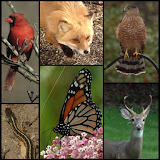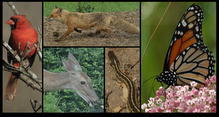
Let's take our birds-in-flight series to the raptors - a type of bird that we find soaring high about the Colvin Run Habitat, as well as down perched on tree branches and sometimes on the ground.

We start with the Red-Shouldered Hawk shown in all but the very last photo. In the first photo through a bit of digital darkroom magic, we have a red-shouldered hawk circling a few hundred feet above the Habitat. Same hawk, each photo taken about a second apart.

In the second and third photos, we get a from-the-underside and from a head-on perspective. The hawk in the third photo was only 20 to 30 feet above the camera location.

A friend, who recently moved to Austin, Texas, sent an email this week saying that her new residence had lots of hawks. In the exchange of emails, we shared our mutual frustration in attempting to identify specific species. The identification is made difficult as the hawks typically do not allow get close enough to make possible an identification (long lens are required). Further there are multiple subspecies (the red-shouldered has 5 subspecies) - and then there are the variations of immatures versus matures (immatures are sometimes larger than mature males), female versus male (female hawks are typically the larger of the two), then eastern versus western variety within each species, and the complexity grows from there.

There are three photos here of red-shouldered hawks with trees in the photo.

I include these trees-in-the-photo shots to give some reference of size. I have measured red-shouldered hawks in the Habitat with wingspans of nearly 5 feet.

In the next photo, we have a red-shouldered hawk (bottom right hand corner) and a red-tailed hawk. So how do I typically tell the two apart? First, the red-shouldered hawks have alternating white and dark bars on the tail; the red-tailed hawks have as the name says a red tail. Second, the red-shouldered hawk as its name says has a red shoulder and redish-orange breast, where the red-tailed hawk has pale wing undersides and pale breast. Thank goodness these photos were taken in January, when the broad-winged hawks are in central and south America, where they winter. The broad-winged and the red-shouldered are primarily differentiated by the size and number of bars on their tails.

The closest observed red-tailed hawk was one about 50 feet above the Habitat.

 Let's take our birds-in-flight series to the raptors - a type of bird that we find soaring high about the Colvin Run Habitat, as well as down perched on tree branches and sometimes on the ground.
Let's take our birds-in-flight series to the raptors - a type of bird that we find soaring high about the Colvin Run Habitat, as well as down perched on tree branches and sometimes on the ground. We start with the Red-Shouldered Hawk shown in all but the very last photo. In the first photo through a bit of digital darkroom magic, we have a red-shouldered hawk circling a few hundred feet above the Habitat. Same hawk, each photo taken about a second apart.
We start with the Red-Shouldered Hawk shown in all but the very last photo. In the first photo through a bit of digital darkroom magic, we have a red-shouldered hawk circling a few hundred feet above the Habitat. Same hawk, each photo taken about a second apart. In the second and third photos, we get a from-the-underside and from a head-on perspective. The hawk in the third photo was only 20 to 30 feet above the camera location.
In the second and third photos, we get a from-the-underside and from a head-on perspective. The hawk in the third photo was only 20 to 30 feet above the camera location. A friend, who recently moved to Austin, Texas, sent an email this week saying that her new residence had lots of hawks. In the exchange of emails, we shared our mutual frustration in attempting to identify specific species. The identification is made difficult as the hawks typically do not allow get close enough to make possible an identification (long lens are required). Further there are multiple subspecies (the red-shouldered has 5 subspecies) - and then there are the variations of immatures versus matures (immatures are sometimes larger than mature males), female versus male (female hawks are typically the larger of the two), then eastern versus western variety within each species, and the complexity grows from there.
A friend, who recently moved to Austin, Texas, sent an email this week saying that her new residence had lots of hawks. In the exchange of emails, we shared our mutual frustration in attempting to identify specific species. The identification is made difficult as the hawks typically do not allow get close enough to make possible an identification (long lens are required). Further there are multiple subspecies (the red-shouldered has 5 subspecies) - and then there are the variations of immatures versus matures (immatures are sometimes larger than mature males), female versus male (female hawks are typically the larger of the two), then eastern versus western variety within each species, and the complexity grows from there. There are three photos here of red-shouldered hawks with trees in the photo.
There are three photos here of red-shouldered hawks with trees in the photo. I include these trees-in-the-photo shots to give some reference of size. I have measured red-shouldered hawks in the Habitat with wingspans of nearly 5 feet.
I include these trees-in-the-photo shots to give some reference of size. I have measured red-shouldered hawks in the Habitat with wingspans of nearly 5 feet. In the next photo, we have a red-shouldered hawk (bottom right hand corner) and a red-tailed hawk. So how do I typically tell the two apart? First, the red-shouldered hawks have alternating white and dark bars on the tail; the red-tailed hawks have as the name says a red tail. Second, the red-shouldered hawk as its name says has a red shoulder and redish-orange breast, where the red-tailed hawk has pale wing undersides and pale breast. Thank goodness these photos were taken in January, when the broad-winged hawks are in central and south America, where they winter. The broad-winged and the red-shouldered are primarily differentiated by the size and number of bars on their tails.
In the next photo, we have a red-shouldered hawk (bottom right hand corner) and a red-tailed hawk. So how do I typically tell the two apart? First, the red-shouldered hawks have alternating white and dark bars on the tail; the red-tailed hawks have as the name says a red tail. Second, the red-shouldered hawk as its name says has a red shoulder and redish-orange breast, where the red-tailed hawk has pale wing undersides and pale breast. Thank goodness these photos were taken in January, when the broad-winged hawks are in central and south America, where they winter. The broad-winged and the red-shouldered are primarily differentiated by the size and number of bars on their tails. The closest observed red-tailed hawk was one about 50 feet above the Habitat.
The closest observed red-tailed hawk was one about 50 feet above the Habitat.



No comments:
Post a Comment